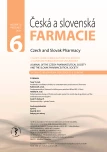Phenylpropanoids and flavonoid from Helichrysum petiolare Hilliard & B. L. Burtt
Authors:
Renata Kubínová; Marcela Nejezchlebová; Markéta Gazdová; Mária Gáborová; Ivana Várady; Lenka Molčanová
Published in:
Čes. slov. Farm., 2021; 70, 206-209
Category:
Original Article
doi:
https://doi.org/https://doi.org/10.5817/CSF2021-6-206
Overview
The phytochemical analysis of a methanolic extract from Helichrysum petiolare Hilliard & B. L. (Asteraceae) confirmed the content of phenylpropanoids and flavonoids. Five secondary metabolites were isolated using preparative HPLC, namely coumarin scopolin (1), 3-chlorogenic acid (2), caffeic acid-hexose derivative (3), dicaffeoylquinic acid (5), and the flavonoid isoquercitrin (4). These compounds were identified from this species for the first time. Only dicaffeoylquinic acid was able to inhibit Escherichia coli CCM 7929 at the concertation of 512 μg ∙ mL–1 in a screening of antibacterial activity.
Keywords:
HPLC – antibacterial activity – Helichrysum petiolare – plant phenols
Sources
- Lourens A. C. U., Viljoen A. M., van Heerden F. R. South African Helichrysum species: A review of the traditional uses, biological activity and phytochemistry, J. Ethnopharmacol. 2008; 119, 630–652.
- Albayraka S., Aksoy A., Sagdic O., Hamzaoglu E. Compositions, antioxidant and antimicrobial activities of Helichrysum (Asteraceae)species collected from Turkey. Food Chem. 2010; 119, 114–122.
- Czinner E., Hagymási K., Blázovics A., Kéry A., Szöke E., Lemberkovics E. In vitro antioxidant properties of Helichrysum arenarium (L.) Moench. J. Ethnopharmacol. 2000; 73, 437–443.
- Jakupovic J., Zdero C., Grenz M., Tsichritzis F., Lehmann L., Hashemi-Nejad S. M., Bohlmann F. Twenty-one acylphloroglucinol and further constituents from South African Helichrysum species. Phytochem. 1989; 28, 1119–1131.
- Ncube N. S., Afolayan A. J., Okoh A. Assessment techniques of antimicrobial properties of natural compounds of plant origin: Current Methods and Future Trends. African J. Biotechnol. 2008; 7, 1797–1806.
- Abdelhamid A. G., Essam A., Hazza M.M. Cell free preparations of probiotics exerted antibacterial and antibiofilm activities against multidrug resistant E. coli. Saudi Pharm. J. 2018; 26, 603–607.
- Schwalbe R., Steele-Moore L., Goodwin A. C. Antimicrobial Susceptibility Testing Protocols. CRC Press 2007, 75–79.
- Bayoumi S. A. L., Rowan M. G., Blagbrough I. S., Beeching J. R. Biosynthesis of scopoletin and scopolin in cassava roots during post-harvest physiological deterioration: The E-Z-isomerisation stage. Phytochemistry 2008; 69, 2928–2936.
- Morikawa T., Wang L.-B., Nakamura S., Ninomiya K., Yokoyama E., Matsuda H., Muraoka O., Wu L.-J., Yoshikawa M. Medicinal flowers. New flavanone and chalcone glycosides, Arenariumosides I, II, III, and IV, and tumor necrosis factor-α inhibitors from Everlasting, flowers of Helichrysum arenarium. Chem. Pharm. Bull. 2009; 57, 361–367.
- Clifford M. N., Johnston K. L., Knight S., Kuhnert N. Hierarchical scheme for LC-MSn identification of chlorogenic acids. J. Agric. Food Chem. 2003; 51, 2900–2911.
- Wu Z.-J., Ma X.-L., Fang D.-M., Qi H.-Y., Ren W.-J., Zhang G.-L. Analysis of Caffeic Acid Derivatives from Osmanthus Yunnanensis Using Electrospray Ionization Quadrupole Time-of-Flight Mass Spectrometry. Eur. J. Mass Spectrom. 2009; 15, 415–429.
- Gouveia S. C., Castilho P. C. Characterization of phenolic acid derivatives and flavonoids from different morphological parts of Helichrysum obconicum by a RP- -HPLC-DAD-(-)–ESI-MSn method. Food Chemistry 2011; 129, 333–344.
- Carlotto J., da Silva L. M., Dartora N., Maria-Ferreira D., de A. Sabry D., Filho A. P. S., de Paula Werner M. F., Sassaki G. L., Gorin P. A. J., Iacomini M., Cipriani T. R., de Souza L. M. Identification of a dicaffeoylquinic acid isomer from Arctium lappa with a potent anti-ulcer activity. Talanta 2015; 135, 50–57.
- Lou Z., Wang H., Zhu S., Ma Ch., Wang Z. Antibacterial Activity and Mechanism of Action of Chlorogenic Acid. J. Food Sci. 2011; 76, 398–403.
- Han J., Lv Q. Y., Jin S. Y., Zhang T. T., Jin S. X., Li X. Y., Yuan H. L. Comparison of anti-bacterial activity of three types of di-O-caffeoylquinic acids in Lonicera japonica flowers based on microcalorimetry. Chin. J. Nat. Med. 2014; 12, 108–113.
- Scott G., Springfield E. P., Coldrey N. A pharmacognostical study of 26 South African plant species used as traditional medicines. Pharm. Biol. 2004; 42, 186–213.
Labels
Pharmacy Clinical pharmacologyArticle was published in
Czech and Slovak Pharmacy

2021 Issue 6
Most read in this issue
- Supply of medicines in the Terezín ghetto
- Antibiotics and the quality indicators for outpatient antibiotic use in Slovakia
- XLII. pracovní den Radiofarmaceutické sekce ČSNM
- Preformulation design of PLGA particulate system for multi-day drug delivery of the antidepressant mirtazapine
